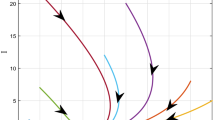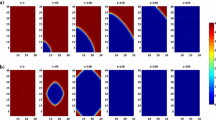Abstract
In this paper, we use discrete gradient methods for numerical solutions of mathematical models of epidemiology: a susceptible infected recovered infected (SIRI) model. The numerical results mimic the true and qualitatively correct behavior of the SIRI model. The first integrals (also known as the constant of motion) of the SIRI model obtained in literature using partial Lagrangian approach are well preserved by the discrete gradient method. The graphical results verify the advantages of the proposed schemes.



Similar content being viewed by others
References
Bernoulli, D.: Essai d’une nouvelle analyse de la mortalité causée par la petite vérole, et des avantages de l’inoculation pour la prévenir. Histoire de l’Acad., Roy. Sci.(Paris) avec Mem pp. 1–45, (1760)
Biazar, J.: Solution of the epidemic model by adomian decomposition method. Appl. Math. Comput. 173(2), 1101–1106 (2006)
Dahlby, M.; Owren, B.; Yaguchi, T.: Preserving multiple first integrals by discrete gradients. J. Phys. A: Math. Theor. 44(30), 305205 (2011)
Derrick, W.; Van Den Driessche, P.: A disease transmission model in a nonconstant population. J. Math. Biol. 31(5), 495–512 (1993)
Edwards, M.; Nucci, M.: Application of lie group analysis to a core group model for sexually transmitted diseases. J. Nonlinear Math. Phys. 13(2), 211–230 (2006)
Habib, Y.: Long-term behaviour of G-symplectic methods. Ph. D. thesis, university of Auckland, New Zealand., (2010)
Hairer, E.; Lubich, C.; Wanner, G.: Geometric Numerical Integration: Structure-Preserving Algorithms for Ordinary Differential Equations, vol. 31. Springer, Berlin (2006)
Irshad, W.; Habib, Y.; Farooq, M.U.: A complex lie-symmetry approach to calculate first integrals and their numerical preservation. Symmetry 11(1), 11 (2019)
Kara, A.; Mahomed, F.: Noether-type symmetries and conservation laws via partial lagrangians. Nonlinear Dyn. 45(3–4), 367–383 (2006)
Kara, A.; Mahomed, F.; Naeem, I.; Wafo Soh, C.: Partial noether operators and first integrals via partial lagrangians. Math. Methods Appl. Sci. 30(16), 2079–2089 (2007)
Kermack, W.O.; McKendrick, A.G.: A contribution to the mathematical theory of epidemics. Proc R Soc of london. Ser A, Contain. Pap. Math. Phys. Character 115(772), 700–721 (1927)
Korobeinikov, A.; Wake, G.C.: Lyapunov functions and global stability for sir, sirs, and sis epidemiological models. Appl. Math. Lett. 15(8), 955–960 (2002)
Levitas, V.I.; Roy, A.M.: Multiphase phase field theory for temperature- and stress-induced phase transformations. Phys. Rev. B 91, 174109 (2015)
Levitas, V.I.; Roy, A.M.: Multiphase phase field theory for temperature-induced phase transformations: formulation and application to interfacial phases. Acta Mater. 105, 244–257 (2016)
Levitas, V.I.; Roy, A.M.; Preston, D.L.: Multiple twinning and variant-variant transformations in martensite: phase-field approach. Phys. Rev. B 88(5), 054113 (2013)
Mansfield, E.L.; Quispel, G.R.W.: On the construction of discrete gradients. Technical Report, University of Kent, Canterbury, UK (2009)
McLachlan, R.I.; Quispel, G.; Robidoux, N.: Geometric integration using discrete gradients. Philos. Trans. R. Soc. Lond. Ser A: Math. Phys. Eng. Sci. 357(1754), 1021–1045 (1999)
Naz, R.; Mahomed, F.; Chaudhry, A.: A partial hamiltonian approach for current value hamiltonian systems. Commun. Nonlinear Sci. Numer. Simul. 19(10), 3600–3610 (2014)
Naz, R.; Mahomed, K.; Naeem, I.: First integrals and exact solutions of the siri and tuberculosis models. Math. Methods Appl. Sci. 39(15), 4654–4666 (2016)
Nucci, M.; Leach, P.: An integrable sis model. J. Math. Anal. Appl. 290(2), 506–518 (2004)
Nucci, M.; Leach, P.: Lie integrable cases of the simplified multistrain/two-stream model for tuberculosis and dengue fever. J. Math. Anal. Appl. 333(1), 430–449 (2007)
Nucci, M.C.: Using lie symmetries in epidemiology. Electron. J. Diff. Equ. Conf 12, 87–101 (2005)
Quispel, G.; Capel, H.: Solving odes numerically while preserving a first integral. Phys. Lett. A 218(3–6), 223–228 (1996)
Rafei, M.; Daniali, H.; Domiri ganji., D.: Variational iteration method for solving the epidemic model and the prey and predator problem. Appl. Math. Comput. 186, 1701–1709 (2007)
Rafei, M.; Ganji, D.; Daniali, H.: Solution of the epidemic model by homotopy perturbation method. Appl. Math. Comput. 187(2), 1056–1062 (2007)
Sanz-Serna, J.M.: Runge-kutta schemes for Hamiltonian systems. BIT Numer. Math. 28(4), 877–883 (1988)
Sanz-Serna, J.M.; Calvo, M.P.: Symplectic numerical methods for hamiltonian problems. Int. J. Mod. Phys. C 4(02), 385–392 (1993)
Sanz-Serna, J.M.; Calvo, M.P.: Numerical Hamiltonian Problems. Chapman and Hall, London (1994)
Funding
This research did not receive any specific grant from funding agencies in the public, commercial or not-for-profit sectors.
Author information
Authors and Affiliations
Corresponding author
Rights and permissions
About this article
Cite this article
Shehzad, F., Habib, Y., Rashid, A. et al. Discrete Gradient Methods for Solving SIRI Epidemic Model Numerically While Preserving First Integrals. Arab J Sci Eng 46, 663–668 (2021). https://doi.org/10.1007/s13369-020-04726-w
Received:
Accepted:
Published:
Issue Date:
DOI: https://doi.org/10.1007/s13369-020-04726-w




